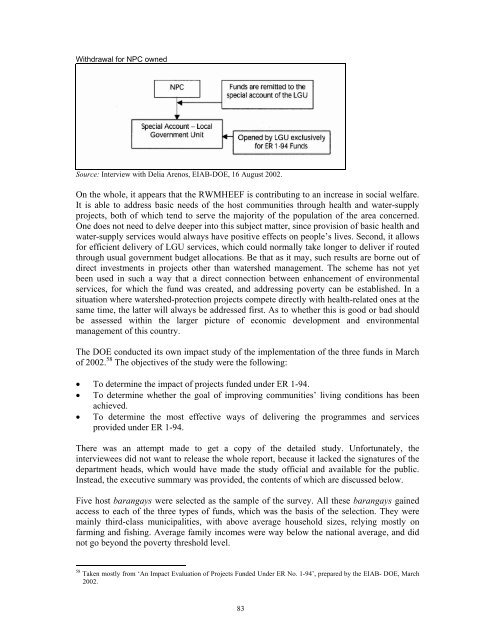Developing pro-poor markets for environmental services in the ...
Developing pro-poor markets for environmental services in the ...
Developing pro-poor markets for environmental services in the ...
You also want an ePaper? Increase the reach of your titles
YUMPU automatically turns print PDFs into web optimized ePapers that Google loves.
Withdrawal <strong>for</strong> NPC owned<br />
Source: Interview with Delia Arenos, EIAB-DOE, 16 August 2002.<br />
On <strong>the</strong> whole, it appears that <strong>the</strong> RWMHEEF is contribut<strong>in</strong>g to an <strong>in</strong>crease <strong>in</strong> social welfare.<br />
It is able to address basic needs of <strong>the</strong> host communities through health and water-supply<br />
<strong>pro</strong>jects, both of which tend to serve <strong>the</strong> majority of <strong>the</strong> population of <strong>the</strong> area concerned.<br />
One does not need to delve deeper <strong>in</strong>to this subject matter, s<strong>in</strong>ce <strong>pro</strong>vision of basic health and<br />
water-supply <strong>services</strong> would always have positive effects on people’s lives. Second, it allows<br />
<strong>for</strong> efficient delivery of LGU <strong>services</strong>, which could normally take longer to deliver if routed<br />
through usual government budget allocations. Be that as it may, such results are borne out of<br />
direct <strong>in</strong>vestments <strong>in</strong> <strong>pro</strong>jects o<strong>the</strong>r than watershed management. The scheme has not yet<br />
been used <strong>in</strong> such a way that a direct connection between enhancement of <strong>environmental</strong><br />
<strong>services</strong>, <strong>for</strong> which <strong>the</strong> fund was created, and address<strong>in</strong>g poverty can be established. In a<br />
situation where watershed-<strong>pro</strong>tection <strong>pro</strong>jects compete directly with health-related ones at <strong>the</strong><br />
same time, <strong>the</strong> latter will always be addressed first. As to whe<strong>the</strong>r this is good or bad should<br />
be assessed with<strong>in</strong> <strong>the</strong> larger picture of economic development and <strong>environmental</strong><br />
management of this country.<br />
The DOE conducted its own impact study of <strong>the</strong> implementation of <strong>the</strong> three funds <strong>in</strong> March<br />
of 2002. 58 The objectives of <strong>the</strong> study were <strong>the</strong> follow<strong>in</strong>g:<br />
• To determ<strong>in</strong>e <strong>the</strong> impact of <strong>pro</strong>jects funded under ER 1-94.<br />
• To determ<strong>in</strong>e whe<strong>the</strong>r <strong>the</strong> goal of im<strong>pro</strong>v<strong>in</strong>g communities’ liv<strong>in</strong>g conditions has been<br />
achieved.<br />
• To determ<strong>in</strong>e <strong>the</strong> most effective ways of deliver<strong>in</strong>g <strong>the</strong> <strong>pro</strong>grammes and <strong>services</strong><br />
<strong>pro</strong>vided under ER 1-94.<br />
There was an attempt made to get a copy of <strong>the</strong> detailed study. Un<strong>for</strong>tunately, <strong>the</strong><br />
<strong>in</strong>terviewees did not want to release <strong>the</strong> whole report, because it lacked <strong>the</strong> signatures of <strong>the</strong><br />
department heads, which would have made <strong>the</strong> study official and available <strong>for</strong> <strong>the</strong> public.<br />
Instead, <strong>the</strong> executive summary was <strong>pro</strong>vided, <strong>the</strong> contents of which are discussed below.<br />
Five host barangays were selected as <strong>the</strong> sample of <strong>the</strong> survey. All <strong>the</strong>se barangays ga<strong>in</strong>ed<br />
access to each of <strong>the</strong> three types of funds, which was <strong>the</strong> basis of <strong>the</strong> selection. They were<br />
ma<strong>in</strong>ly third-class municipalities, with above average household sizes, rely<strong>in</strong>g mostly on<br />
farm<strong>in</strong>g and fish<strong>in</strong>g. Average family <strong>in</strong>comes were way below <strong>the</strong> national average, and did<br />
not go beyond <strong>the</strong> poverty threshold level.<br />
58<br />
Taken mostly from ‘An Impact Evaluation of Projects Funded Under ER No. 1-94’, prepared by <strong>the</strong> EIAB- DOE, March<br />
2002.<br />
83
















